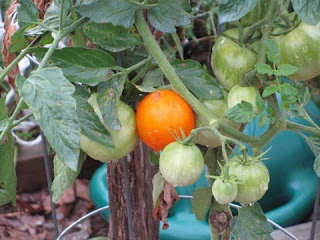 |
| "Breaker Stage" tomatoes when picked |
Photo 1 shows the four tomatoes when I picked them on July 25. Back row: Brandywine Red, Brandywine (Sudduth’s Strain), and Virginia Sweets. Front row: Big Mama and a common cherry tomato, Sungold. I added the Sungold to give an idea of the comparative sizes of the fruit. The Sungold within a day disappeared in a sudden gnashing of my teeth, and the Big Mama surrendered peacefully to a slicing knife on Thursday evening when Ellen and I were making sandwiches.
 |
| "Breakers" four days later |
How did they taste? Did they have the exciting flavor of vine-ripened tomatoes—as my earlier posting suggested would be the case? Or were they “off flavor” or even as tasteless as the tomatoes we’re accustomed to bringing home from the supermarket?
I was particularly interested in seeing how the Brandywine (Sudduth’s Strain) and the Virginia Sweets, both heirlooms varieties, ripened inside. Over the years I’ve “lost” many of that pink Brandywine because I stubbornly let them hang on their vines while I waited for their color to intensify. I wanted a deep pink, I suppose—but the fruit often cracked and rotted before I decided to pick it. Conventional wisdom says heirloom tomatoes ripen internally before they appear ripe externally.
The Virginia Sweets is a new variety for me this year, and I didn’t really know what it would look like when ripe. Its seed packet describes mature fruit as “gold-red bicolors” and “golden yellow beefsteaks … colored with red stripes that turn into a ruby blush.” Just what would that look like out in the garden?
 |
| Sliced "breakers" |
However, I’ve learned a few things during this experiment.
First, I’ll pick tomatoes even earlier—when they’re just beginning to add color and before they are “nearly ripe” or show any signs of cracking or other problems. The Brandywine Red was almost too ripe by the time I sliced it. The Sudduth’s Brandywine had begun to crack on the vine, and the crack widened as it ripened in the kitchen, so I had to dispose of more of the “meat” that I wanted to eat.
Second, I will start slicing heirlooms, such as the Brandywines, before they look absolutely ripe on the outside. I’ve accepted the conventional wisdom that they are ripe inside before they look ripe.
When I was preparing to take a picture of the tomatoes, I happened to think that I’ve never weighed tomatoes. I grow them to eat, and eat them we do. But just to see how much they weighed, I got out a simple kitchen scale. Here are their approximate weights:
Sungold, not large enough to accurately weigh.
Big Mama, 5 ounces (140 g). (This is a small Big Mama according to the Burpee catalog description.)
Brandywine Red, 15 ounces (425 g).
Brandywine (Sudduth’s Strain), 1 lb 1 oz (480 g).
Virginia Sweets, 1 lb 9 oz (800 g). Yes, that is one large tomato, impressive even while hanging on the vine.
Have you picked tomatoes before they were fully ripe? If you have, please post a Comment about how picking at breaker stage works for you and how you think the ripened fruit tastes. Does it taste as good as vine-ripened fruit? And if you grow heirlooms, share a tip about how you tell when they’re ripe?
Grow it. Experiment. Eat it. Comment.
P.S. If you didn’t read my earlier posting about picking tomatoes at breaker stage and want more information, CLICK HERE.





































